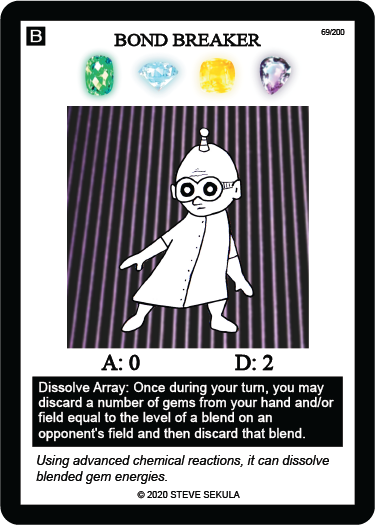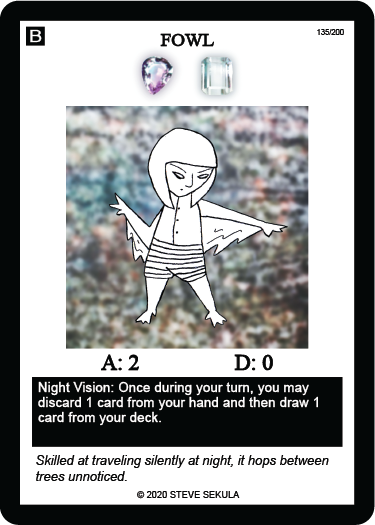In this post, we’ll focus on the basic tenets of deck building, which are essential to maximizing the power of your cards. These tips are intended for players who have played the starter decks and want to up their game by using the other cards in the full Base Collection. Also, deck building is by no means an exact science, so feel free to play around with each of the tips below. Here we go!
TIP #1: REMEMBER THE DECK CONSTRAINTS
Although it seems basic, knowing what the deck building restrictions are is crucial in deck construction. Every deck must have:
• 4 heroes (and up to 4 additional heroes on your bench, see “Bench” in the advance section of the Complete Rulebook) • 50 non-hero cards • No more than 5 action stars
• No more than 1 copy of each special gem • No more than 3 copies of each action or blend (there is no limit on basic gems)
TIP #2: BEGIN WITH A HIGH LEVEL “SEED” BLEND
As is apparent in both Storm Strike and Rage Cemetery, the strategies for both decks are heavily reliant on the LV. 5 blends Storm Weaver and Rage Domesticator. That makes sense — LV. 5 blends have the highest stats and most powerful effects in the game, so you want to start there! First, pick out the LV. 5 blend you want to base your deck around. For the purposes of this blog, we will pick one of my favorites: Verve Conflicter.
TL;DR: Pick out one LV. 5 blend!
TIP #3: SCOUT OUT LOWER LEVEL BLENDS
In Tip #2, we already have the beginnings of a strategy in place. Now we need other blends that fit these constraints! First, you can check out the gem make-up of other blends. I tend to run no more than 5 gem types unless absolutely necessary because extra gems can clog your deck and slow down your engine. For Verve, that means we can already rule out any blend that uses an Aquagem, Pyrogem, Luciogem, or Caprogem. Now we can go through the remaining pool of blends, from high levels to low levels (starting with LV. 4 down to LV. 2). Right away, you can see that Break Detector, Bond Breaker, Wood Ghost, Signal Corruptor, and Corruptor work well with the gem make up. As an added bonus, these blends have effects that either get your opponent’s blends in their discard or benefit from it. Also, Cone (a personal favorite of mine) fits Verve’s gem makeup and allows you to search for gems very easily.
It’s up to you to decide how many of each blend to run (max of 3 each). Since we are using a Standard Base Collection to build this deck, we do not have access to multiple copies of upper level blends. However, if we did have multiple Master Sets to pull from, I would definitely include multiple copies of Verve Conflicter and Bond Breaker. Any deck should have about 15 blends total (give or take).
Blends: 1 x Verve Conflicter 1 x Break Detector 1 x Bond Breaker 2 x Signal Corruptor 2 x Wood Ghost 2 x Cone 2 x Corruptor 3 x Fowl Total: 14 Blends
TL;DR: Use your LV. 5 blend’s effect and gem makeup to select the other blends in your deck until you have around 15 blends total.
TIP #4: PICK YOUR GEMS
Now that you’ve selected your blends, it’s time to choose your gems. On average, decks tend to have about 20 gems. This number can vary drastically, especially when you’re running effects that require you to discard or accumulate a specific gem type. In this case, we are going to look at our blends to decide how many of each gem to put in the deck. Since Cone is an important low-level support blend that we can get out early, it’ll be important to have Terragems and Cryogems in higher than average numbers to help us search for the other gems we need. Similarly, Fowl is an exceptional LV. 2 blend that gives us some early attack damage paired with a deck-cycling effect, so Nocturnagems and Aerogems will be important as well. Let’s throw in a bunch of those gems and 3 Electrogems to give us 20 gems total.
Gems: 5 x Terragem 4 x Cryogem 4 x Nocturnagem 3 x Electrogem 4 x Aerogem Total: 20 Gems
TL;DR: Once you’ve selected your blends, take a look at the gems they require. Add gems to your deck according to how often each gem type occurs and/or what blends you want to get out early on. Generally, decks have around 20 gems total.
TIP #5: CHOOSE YOUR ACTIONS
Actions usually won’t be the main strategy of your deck, but they are supporting pieces that help you accrue resources and advance your strategy. There are several actions that I think should be in any deck regardless of strategy: Gem Search, Collect, Cancel, and Draw. You can play with the number of copies of each of these actions to suit the blends you chose earlier. For tips on how to most effectively use these standard actions, see our previous blog post!
Next, think through the 1-, 2-, or 3-star actions that you want to include, but keep in mind that you can only have a total of 5 stars in your deck. Since Verve Conflicter powers up from your opponent’s discard, a Dissolve makes a lot of sense as your 3-star action, which gives you 2 other stars to play with.
Some 1-star actions will work well in any deck, such as Super Blend Search and Super Draw. I would recommend using a mix of these two action cards to round out your starred actions.
Actions: 1 x Dissolve 1 x Super Blend Search 1 x Super Draw 2 x Cancel 3 x Collect 3 x Draw 3 x Gem Search 1 x Struggle Switch 1 x Struggle Stun Total: 16 Actions
TL;DR: Some actions like Gem Search, Collect, Cancel, and Draw will be useful regardless of your strategy. Select your starred actions to supplement and enhance your blend effects, but note that you may only have a total of 5 stars in your deck.
TIP #6: SELECT YOUR HEROES
Note: Depending on your LV. 5 seed blend, you might already have an idea of which heroes you want to add to your deck. That’s totally fine — there’s no need to stick to this deckbuilding order!
Heroes are a bit tricky to pick out because there are so many options, and each combination of heroes will impact how your deck plays. Remember that lower level heroes tend to have better abilities and stats than higher level heroes, but we will also need at least one LV. 5 hero in order to play Verve Conflicter (since Verve is a LV. 5 blend). I tend to pick a combination of heroes with “On your first turn” effects and heroes with permanent and recurring effects. There are a few first-turn effect heroes that will be helpful for any deck: Erica, Jewl, Claire, Judith, Monica, Selma, and Fatima.
When considering our Verve template, any of the heroes listed above can help you get your deck started. I’m always partial to searching abilities, so I would go with Fatima and Erica to start off. Erica also checks off our LV. 5 blend for the deck.
Now that we have plenty of gem search options with Erica, Fatima, and Cone, let’s fill in the gaps. Switching is a very important ability for any deck, whether it comes from your actions, your blends, or your heroes. Since we don’t have any actions or blends that let us switch, let’s add Marci to the mix. Not only does she have a switching effect, but she’s a LV. 4, so she can use some powerful blends as well.
Looking at our range of hero levels, I’d say we have room for a LV. 1 support blend with a powerful effect. Min-Seo will be a great addition to help us get our engine going, allowing us to search for Cones, Fowls, and Corruptors early on.
Now that we chose our heroes, we’re all done! Here is one potential decklist you might have created with this guide — if yours is different, that’s totally fine!
Heroes: 1 x Erica 1 x Marci 1 x Fatima 1 x Min-Seo Blends: 1 x Verve Conflicter 1 x Break Detector 1 x Bond Breaker 2 x Signal Corruptor 2 x Wood Ghost 2 x Cone 2 x Corruptor 3 x Fowl Actions: 1 x Dissolve 1 x Super Blend Search 1 x Super Draw 2 x Cancel 3 x Collect 3 x Draw 3 x Gem Search 1 x Struggle Stun 1 x Struggle Switch Gems: 5 x Terragem 4 x Cryogem 4 x Nocturnagem 3 x Electrogem 4 x Aerogem Total: 54 Cards
TL;DR: One safe option is to pick a combination of first-turn effect heroes and permanent-effect or recurring-effect heroes. While low-level heroes have stronger effects than high-level ones, make sure to choose heroes with levels that are high enough to accommodate the blends you chose!
If you made it to the end, congratulations! Hopefully this post will provide a framework for you to start building your very own deck. As always, practice makes perfect, and the more decks you build, the quicker and easier it will become. If you have any follow-up questions or want to bounce any ideas off other Gem Blenders, feel free to check out our Discord or write a message below. Looking forward to seeing all of the new strategies people come up with!





















